


Contents
In the 8th Century BC, large-scale ceramic vessels were produced as grave markers. As these were originally decorated with just repeated angular patterns, the style became known as "Geometric" art. As time went by, small portions of the vessel might be filled with simple stick-figure people, often attending a funeral. The first image here is a funerary amphora almost six feet tall, with a detail in the second image.

Amphora

Detail
Here is a cross-section of the types of graves in which these vessels are found, showing their placement.
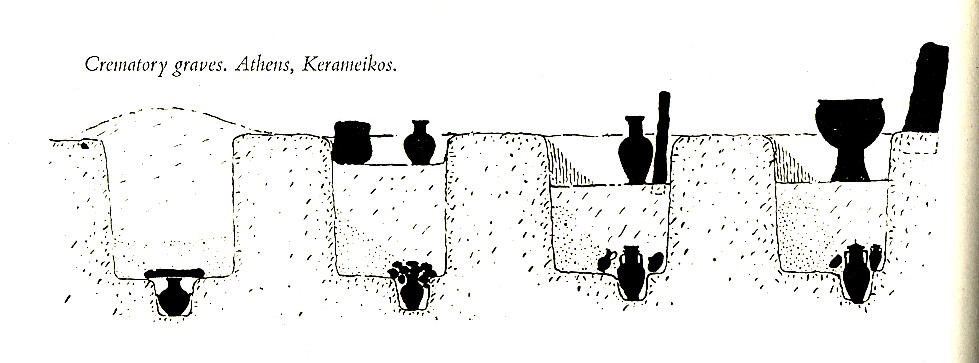
Cemetery
And finally we have a vase from a little later than the first, with more detail, including a chariot procession.
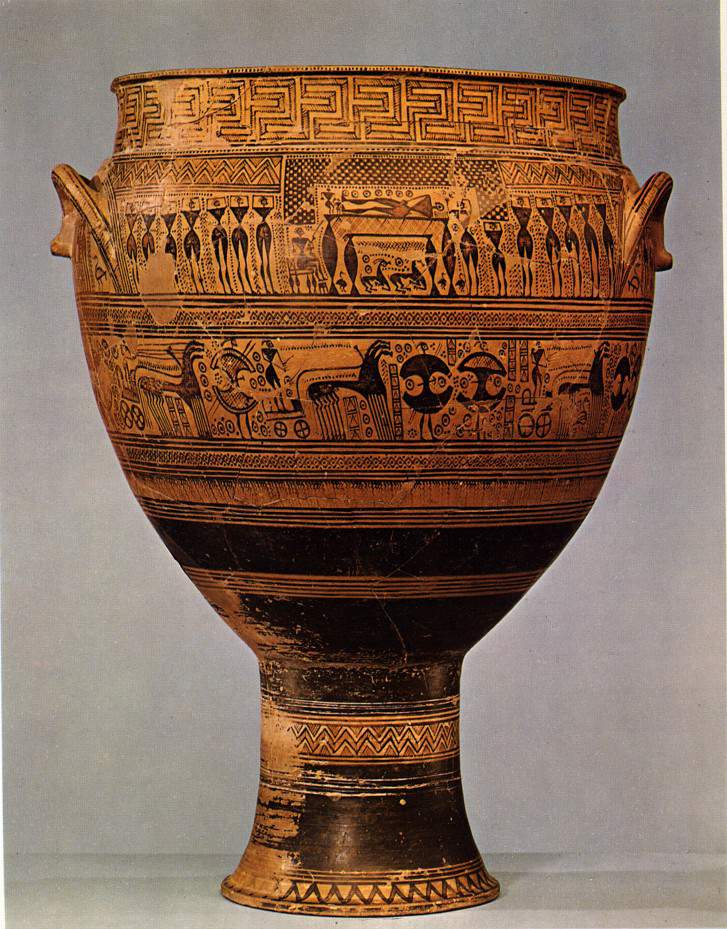
Chariots
But not all geometric vase-paintings are as monumental in size. Here is a small cup decorated with similar stick-figures, apparently engaged in battle. Whether this represented a real or a fictional battle is unknown.

Sea Battle
Within a relatively short time, however, the pictorial scenes increase in size and detail, and shortly after 700 BC we find the first recognizable scenes taken from myths.

Warriors
The Archaic period of Greek art spans about 200 years, from 700 to 500 BC. The two major types of art of this time, vase-painting and sculpture, show a noticeable flourishing of realism and narrative iconography.
The primary technique of Archaic vase-painting (derived from the Geometric style) is known as the black-figure vase-painting technique. The first example below shows one of the very early examples, still somewhat rough and sketchy. However, the second example shows the fully-developed technique.
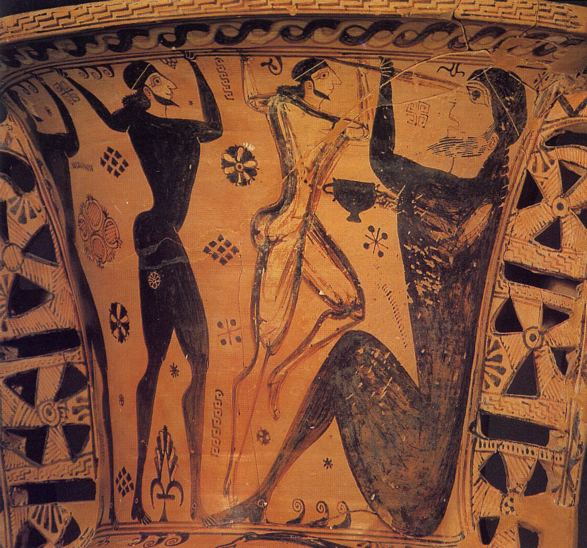
Black figure 1
Note how the major figures are painted primarily with black paint (with a few details added in other colors) on a red-orange colored clay vessel. This does not necessarily mean that the people were black-skinned—it was merely the standard for this style of painting. Notice also that only the male figure is all black, whereas the two females on either side have their skin areas painted in white.

Black figure 2
Unfortunately, the vast majority of Archaic bronze sculptures no longer exist, having been "recycled," i.e., melted down for other uses. A few figures have been found, however.
Also there are some marble sculptures from the Archaic period, many from temples, and often in damaged condition, such as this sculpted metope from Sicily.

Metope
The beginning of the 5th Century B.C. marks the approximate start of the Classical period, which by its very name suggests that this marks the high point, the "golden age," of ancient Greece. In vase-painting, the technique changes from "black-figure" to "red-figure," where the backgrounds (and details) are now painted in black, and the natural color of the red clay now represents flesh tones. Some vase paintings are signed by their artist, while others have such a distinct style we can identify the same hand at work.

Here is one of the finest examples of red-figure vase-painting from an artist known by the pseudonym "Kleophrades Painter."
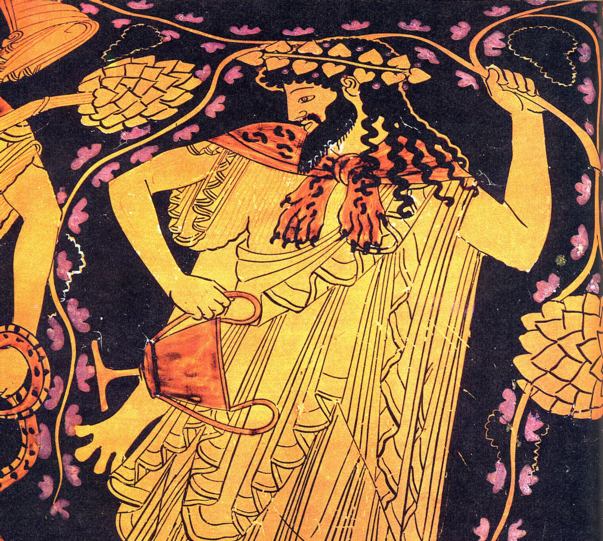
Kleophrades Painter
Bronze sculpture was another major art form of Classical Greece, but as with Archaic bronzes, extremely few still exist today. Those which do, such as the two pictured here, were each discovered in modern times by underwater-archaeologists among the remains of sunken ships.

Bronze god
The Parthenon of Athens (a temple dedicated to the goddess Athena) is one of the major architectural works of the Classical period. It and other temples usually contain scuptures of mythological subjects.

Parthenon

Olympians
The Hellenistic period is usually said to begin with the conquests of Alexander the Great, around 330 B.C., during which time Greek art and culture spread to other lands. The sculptures of Hellenistic times tend to be much more active and intense, often containing groups engaged in violent activity. One of the best examples of this style is the sculptural decoration of the Great Altar of Zeus at Pergamum. The first image shows the goddess Athena gripping a rebellious Giant by the hair.

Athena vs. Giant
Next is a close-up of Artemis' dog biting another giant.
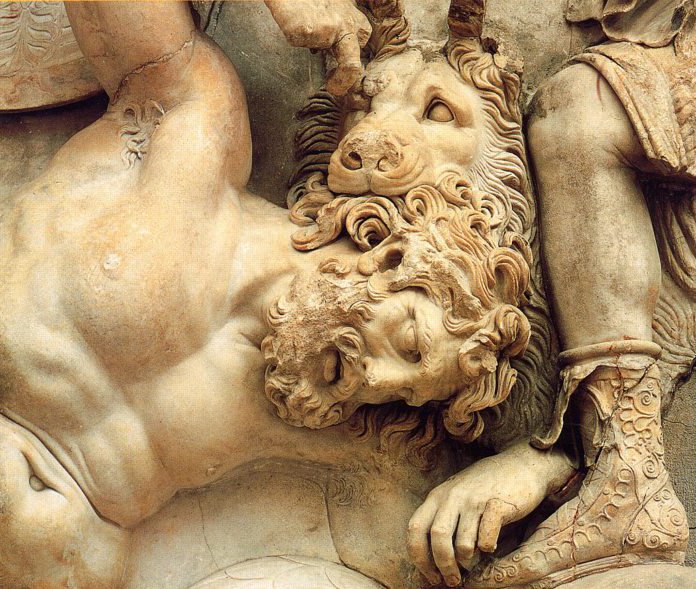
Dog vs. Giant
Another well-known Hellenistic scupture is the Winged Victory of Samothrace, now in the Louvre, Paris.

Winged Victory
Although headless and armless, her rippling garment conveys a real sense of movement.
In general, the sculptures of the Roman period continued the trends of the Hellenistic period, i.e., large, multi-figure groups with great detail and emotional intensity. (In many cases, it is very difficult to distinguish among Hellenistic works, Roman copies of Greek works, and Roman originals.) Good examples are the Farnese Bull and the Laocoön.

Farnese Bull

Laocoön
Many of the most important artworks from Roman times are those which have been discovered in or near the famous buried city of Pompeii. The eruption of nearby Mt. Vesuvius in 79 A.D. completely covered this Roman seaside city but preserved it more-or-less intact. Also buried in the same event was a nearby city called Herculaneum, where many important artworks have been found.
Below is an aerial photo of Pompeii, followed by some ground-level views showing the remains as they appear today.

Aerial photo
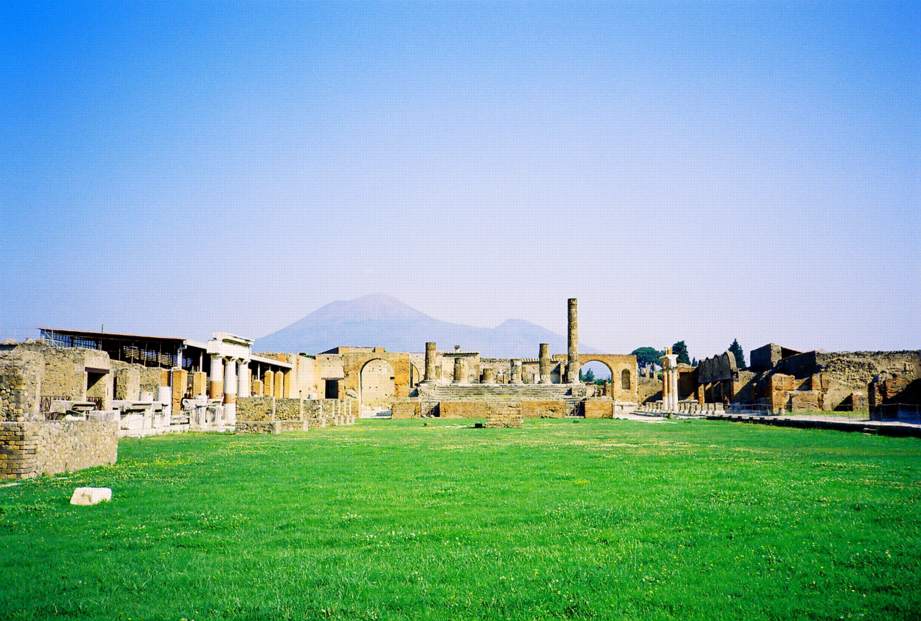
Forum
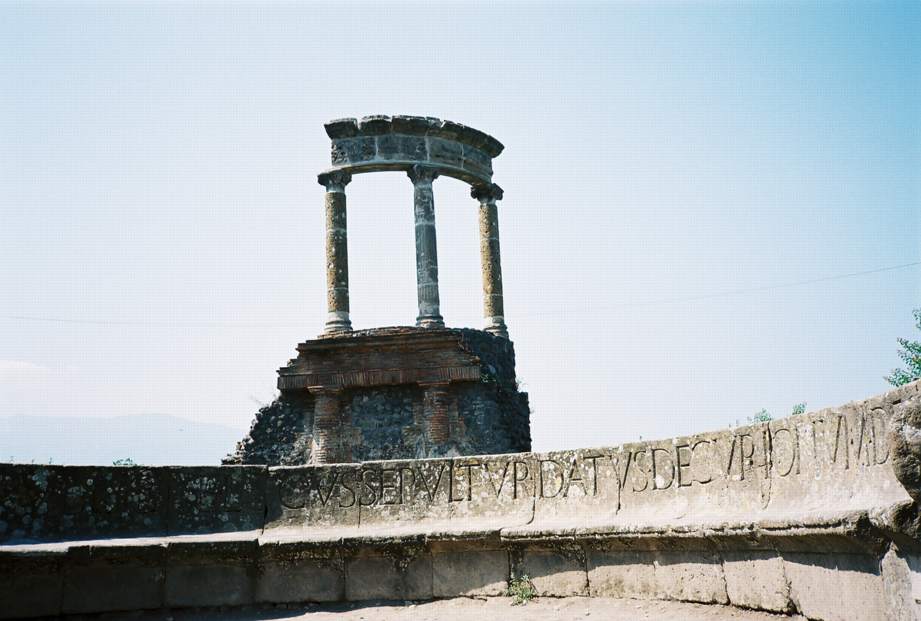
Temple
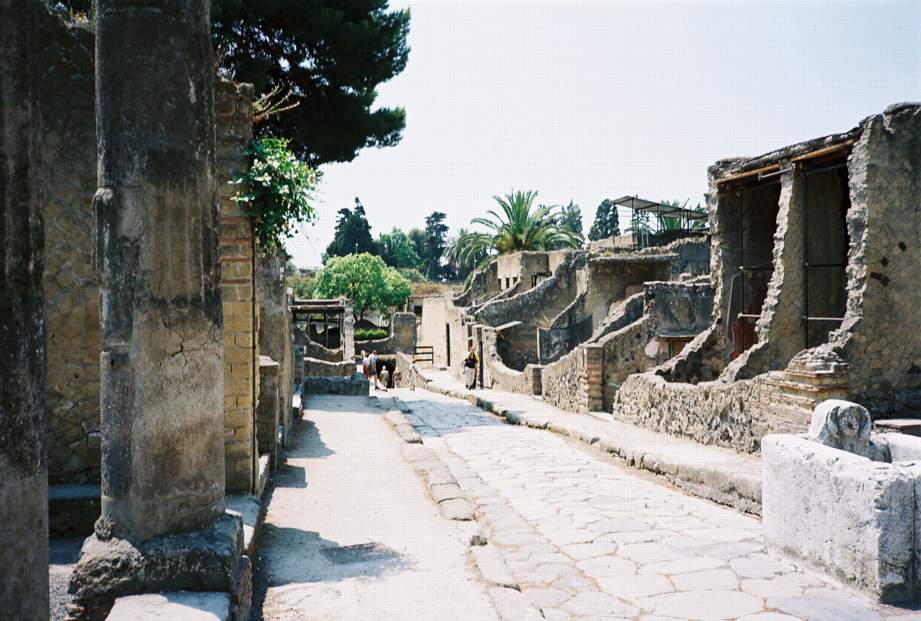
Herculaneum
Not only were items of daily life discovered, but also many painted walls with vivid scenes taken from myths, as seen below.
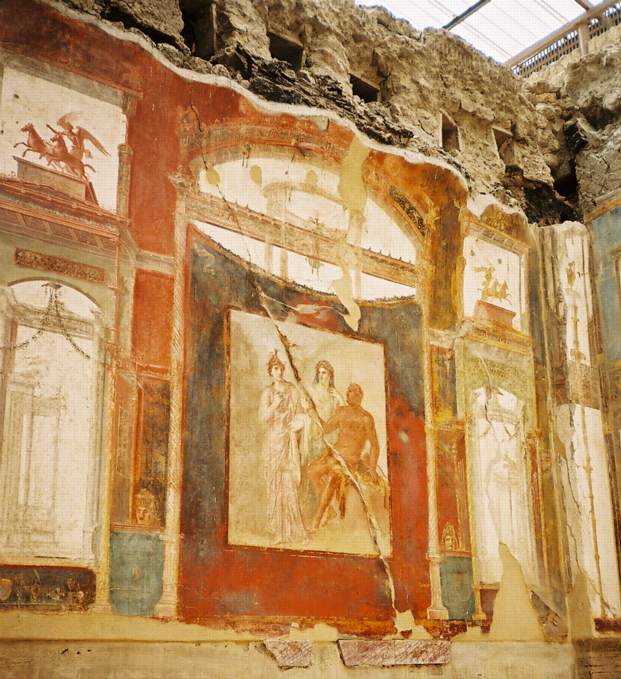
Wall
Another technique at which the Romans were quite skilled was mosaic, the making of pictorial scenes, often quite large, from minute pieces of colored stones.
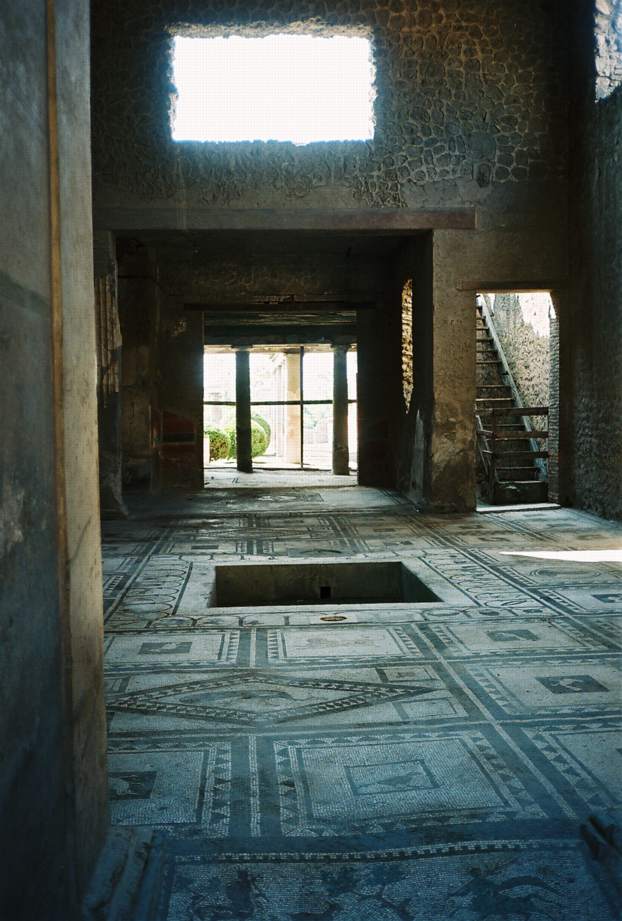
House
With the fall of the (Western) Roman Empire and the start of the Middle Ages, there began a period of about 1000 years during which there was little or no depiction of famous myths in art. It was only around the 14th Century A.D. that the accomplishments of the Classical civilizations were rediscovered or revived, a time now referred to as the Renaissance (a word from French meaning "rebirth"). For this, see the following paragraph.
The Renaissance was the rebirth of the cultural achievements of Classical civilizations. After a long gap of liitle or no interest in the art and literature of the Greeks and Romans, interest was rekindled beginning about 1400 A.D., lasting through this and the following century, the 1500s. The most notable period within this is called the "High Renaissance", the later decades of the 15th Century. Michelangelo Buonarotti is probably the best-known Renaissance artist. His sculpture of David seen below certainly demonstrates a strong influence from Classical Greek scupture and ideals.

David
Besides the works of Michelangelo, we will see many other famous works from the Renaissance, such as Botticelli's "Birth of Venus."
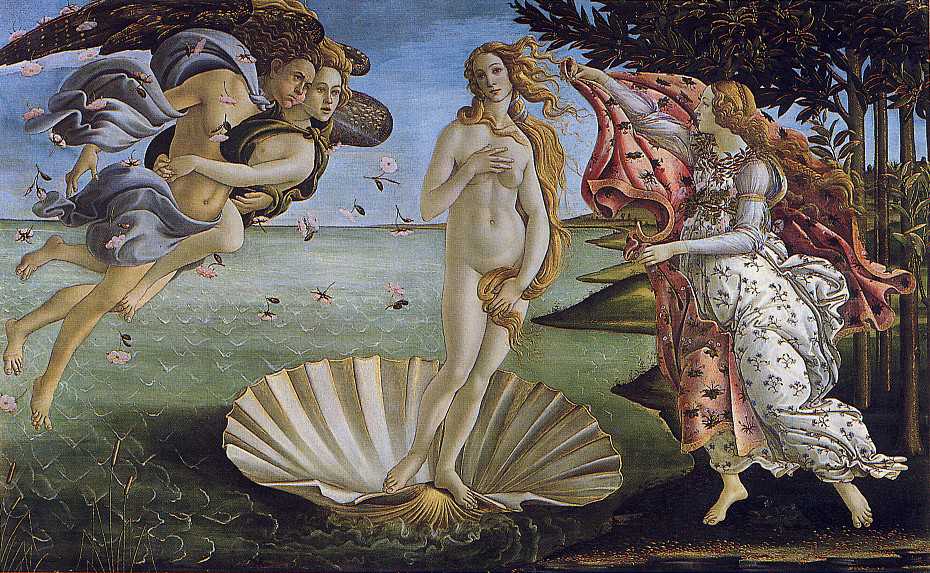
Venus
The 17th Century A.D. (1600s) is known as the Baroque period of European art. Baroque art is generally characterized by an ornateness and a fondess for 'spectacle.' The emphasis is often on large, detailed scenes with huge, multiple-figure scenes with a high sense of drama, absent in most Renaissance art.
One of the most significant Baroque artists is the sculptor Bernini, probably remembered most for his decorative work at the Vatican. Several of his finest works, however, have scenes and subjects taken from Greco-Roman myth, such as his version of 'Apollo and Daphne'.

Bernini
Annibale Carracci was a significant painter of the Baroque period. Here is a general view of his mural paintings for the Farnese Gallery in Rome. Every one of the panels in this huge room has a scene taken from a Greek myth.

Carracci
In the 18th Century, several factors, especially the rediscovery and excavation of Pompeii, combined to rekindle some of the qualities of classical art. To these artists, the Baroque style had become too ornate, too overly-detailed, getting too far away from the restrained elegance of the Classical period. One of the foremost Neoclassical artists was Jacques-Louis David. Below is his painting of "The Death of Socrates." Although it is a historical rather than mythological subject, the figures are posed very much like a classical Greek work.

Socrates
Another major Neoclassicist is Jean-Auguste Ingres. Here is his "Jupiter (Zeus) and Thetis." You can easily see the similarity to ancient classical subjects here.

Zeus
Neoclassicism continued in the 1800s, but another important trend began, termed Romanticism. This was partly a movement away from the strict conventions of Neoclassicism, which these artists perceived as overly strict and preoccupied with formal style. To the Romantic artists, the major factor of a painting was the emotion, the drama which it evoked, rather than an adherence to the (neo-)classical style.

Liberty
Next is one of his mythological works, a painting of the character Medea, depicting an intense emotional moment when this woman is just about to kill her own children.
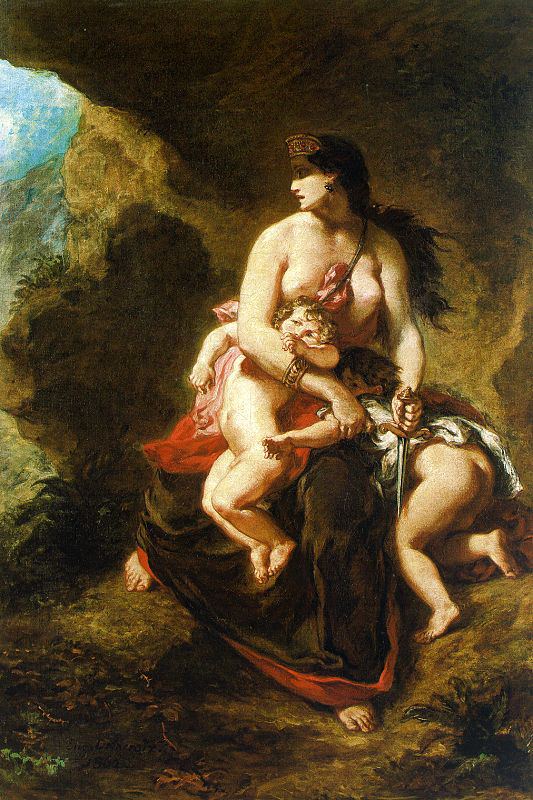
Medea
Although less common than previously, Greek myths continued to inspire some major artists since the beginning of the 20th Century. Here is a painting by the famous surrealist Salvador Dali, entitled "Leda Atomica".

Leda Atomica
And Paul Manship's huge gilded statue of Prometheus at Rockefeller Center, New York City.

Prometheus